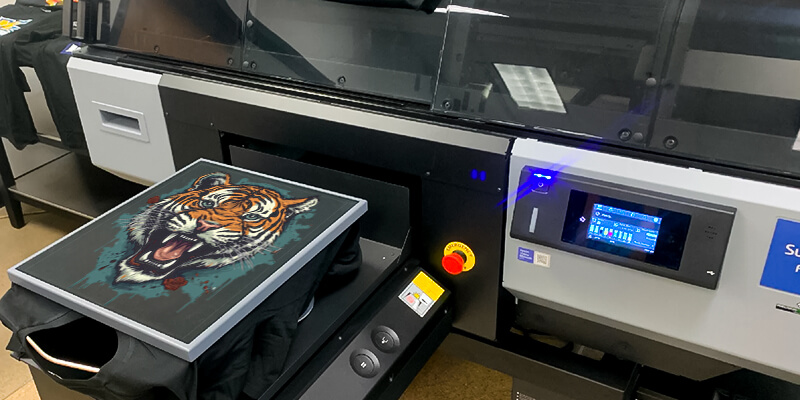If you’re in the business of apparel decoration, you’ve probably come across different printing methods. One such method that has gained popularity in recent years is Direct-to-Garment (DTG) printing. DTG printing offers a unique way to bring your designs to life by spraying ink directly onto garments, resulting in intricate and high-quality prints.
In this guide, we will delve deeper into DTG printing, discuss its advantages and limitations, compare it to other printing methods, and provide some valuable tips for achieving excellent results.
What is DTG Printing?
DTG printing, also known as direct-to-garment printing, uses digital printers to spray water ink onto fabric. Unlike screen printing, which needs the creation of separate screens per color, DTG printing allows for full-color artwork to be printed directly onto the apparel.
The process begins by applying a pre-treatment solution to the fabric, which enables the ink to stick to the fibers effectively. The apparel is then fed into the printer, where the logo gets printed on it. To ensure the longevity of the print, the ink is then cured, enhancing its durability.
When to Choose DTG Printing
DTG printing is the ideal choice when you need to recreate fairly complex designs that involve a wide range of colors. It excels at capturing smaller details and producing vibrant prints, rendering it perfect for complex artwork, images with smooth gradients, or designs requiring precise color matching.
DTG printing also offers great flexibility in terms of quantity. Whether you need a single print or a small batch, DTG printing allows for cost-effective production in smaller quantities. This makes it an excellent option for personalized or custom apparel. However, it’s worth noting that DTG printing is not as time-efficient for bulk orders compared to other methods.
DTG Printing and Fabric Compatibility
While DTG printing works best on 100% cotton fabric, it is also suitable for cotton blends. The level of success may vary depending on the specific DTG machine and ink used, but a minimum of 50% cotton content in the garment is generally advised. Cotton allows for better ink absorption, resulting in higher print quality.
However, advancements in DTG technology have made it possible to print on various fabric types, including polyester and blends. It’s always a good idea to perform test prints on different fabrics to ensure satisfactory results.
DTG vs. Screen Printing
One constant discussion in the world of apparel customization revolves around choosing between DTG and screen printing. DTG printing shines when it comes to intricate and detailed designs with accurate colors. It excels at reproducing artwork or images with smooth gradients, making it the go-to method for high-resolution prints.
Moreover, DTG printing is well-suited for smaller runs and quick turnarounds, making it perfect for on-demand printing services. On the other hand, screen printing offers its own advantages. It is highly durable, cost-effective for large quantities of simpler designs, and provides a wider range of color options, including specialty inks like metallic or neon. Ultimately, the choice between DTG and screen printing depends on your specific needs and priorities.
Tips for Successful DTG Printing
To achieve the best results with DTG printing, here are some valuable tips to keep in mind:
- Pre-Treat Your Garments: Pre-treatment is essential, particularly for dark-colored fabrics. Applying a pre-treatment solution helps the ink adhere better to the fabric, resulting in sharper and more vibrant prints. Follow the manufacturer’s instructions for proper pre-treatment techniques.
- Use High-Quality Images: Ensure your artwork is of high resolution of 300 dpi or higher. High-quality images provide more clarity and detail in the final print. If possible, save your files in vector format to retain optimal quality and scalability.
- Follow Proper Curing Techniques: After printing, it is crucial to follow the recommended curing and drying instructions for the ink used. Curing helps set the ink properly, enhancing its durability and ensuring it withstands regular washing and wear. Improper curing may result in fading or cracking of the print over time.
- Regular Maintenance of the Printer: Consistent maintenance and cleaning of your DTG printer are vital for optimal performance. Refer to the manufacturer’s guidelines for maintenance routines, including cleaning the printheads and replacing ink cartridges. Regular maintenance prevents clogging and ensures consistent print quality.
By following these tips and guidelines, you can maximize the potential of your DTG printer and achieve outstanding results with each print.
Conclusion
DTG printing offers a versatile and efficient method for creating high-quality prints on garments. With its ability to reproduce intricate designs and a wide range of colors, DTG printing has become a popular choice for blank t-shirt decorators. Whether you’re a small business looking to offer personalized products or a creative individual wanting to bring your unique designs to life, DTG printing provides an excellent solution. Happy printing!

